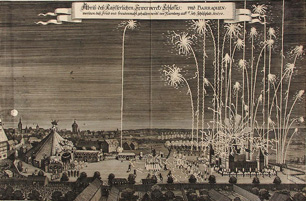Barium
|
EPA Maximum Contaminant Level (MCL) |
2 mg/L |

Among barium's many uses is to help fireworks to explode green.
Barium is a lustrous metal used in the manufacture of a wide assortment of products, including electronics, plastics, rubbers, bleaches, dyes, fireworks, ceramic glazes, glass, enamels, bricks, paper, metal alloys, lubricants, pharmaceuticals and cosmetics.
Barium is also commonly used in the oil and gas industry to soften mud for drilling, where it leaks into the ground and may contaminate groundwater. Other ways it can enter the environment include discharge from metal refineries and erosion of natural deposits.
Health Effects of Barium
At high concentrations, barium can affect the central nervous system, causing paralysis and, with a high enough dosage, death.
Some studies suggest that long-term exposure can lead to high blood pressure and may increase risk of heart disease. According to the EPA:
Some people who drink water containing barium in excess of the maximum contaminant level [2 milligrams per Liter (mg/L) or 2 parts per million (ppm)] over many years could experience an increase in their blood pressure.
Water Treatment for Barium
The EPA recommends ion exchange, reverse osmosis, lime softening or electrodialysis for the treatment of barium.
Sources: EPA, WHO, Image: Wikimedia, author: Unknown
Site Index
Filtration Systems
- Aeration for Iron & Sulfide
- Backwashing Filters
(whole house & well units)
- Chlorine & Chemical Injectors
- Countertop Water Filters
- Garden Hose Filters
- Reverse Osmosis, Residential
- Reverse Osmosis, Commercial
- Shower Filters
- Specialty Filters
- Ultraviolet Systems
- Undersink Filters
- Water Softeners
- Whole House Filters
Cartridges
Parts
- Replacement Parts
- Faucets
- Filter Media
- Fittings
- Housings
- O-rings
- Pumps
- Pura UV
- R.O. Parts
- R.O. Tanks
- R.O. Booster Pump
- VIQUA UV